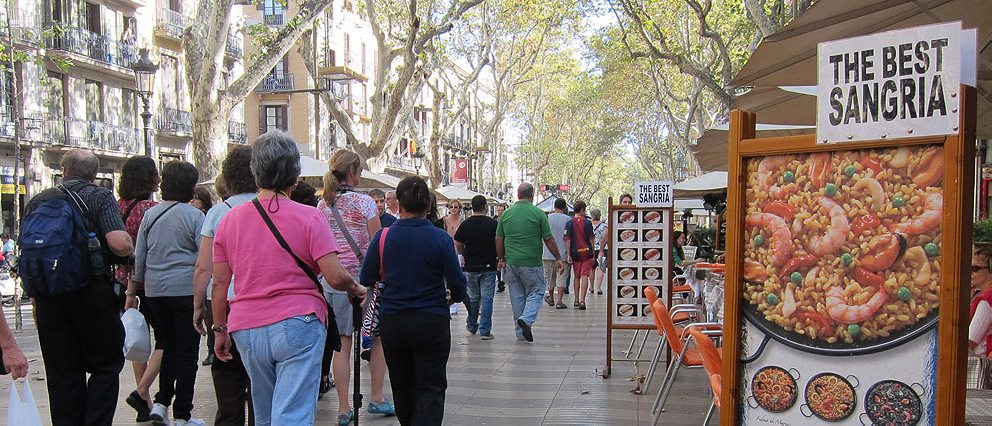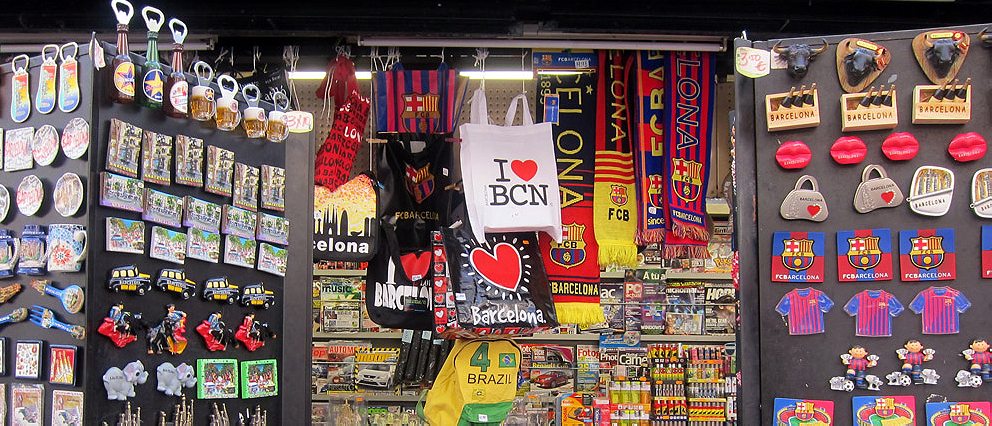
A Tale of Two Cities (in One)

Can a country be both a treasure trove for tourists and an economic and political disaster? An adopted son explores Spain.
It’s the simplest and most loaded question of all: How’s Spain?
“Amazing!”
That’s the part most people want to hear. They’re looking for confirmation that the Spain of their imagination, the one of glossy magazine spreads and post-collegial booze romps, is alive and well. And, in most ways, it is. My office is located in Barcelona’s Plaça Reial, just off La Rambla, the tiled thoroughfare cutting a path from the Mediterranean to the city center, and I as type this, the “amazing” Spain is one floor below me, beaming magnificently in the autumn sun.
Groups of Germans and Brits and Americans drink sangria from great goblets like little kings while servers dish from pans of paella the size of manhole covers. An old man on a stool in the corner of the plaza plucks at the strings of his flamenco guitar, telling an ancient tale of heartbreak and despair (flamenco is from the south of Spain, but the people depositing the contents of their wallets into his hat don’t seem to mind). On the other end of the plaza, a group of shirtless b-boys with a hulking ghetto blaster do things with their bodies that would make a Cirque du Soleil veteran jealous.
I landed in this country by accident. I was on my way to Italy, with a vague plan to hunker down in Bologna to learn Italian and eat giant bowls of tagliatelle al ragu, but at the end of a four-day stopover in Barcelona, I met a Catalan girl and never left. Now I buy my fish from old women with massive cleavers, drink dark, sweet vermouth in the late afternoons, and wake up to the smell of the Mediterranean creeping through my bedroom window. Even after two years living in this country, I find all of this almost too lovely for words.

But despite the aching beauty to be discovered around every corner, what I really want to answer when I’m asked about life in Spain is: “It’s amazing, but…” The “but” might as well be in 44-point bold all caps Helvetica, because as you dig your fingers into this city and into this country, you soon find out that “amazing” doesn’t apply to everyone.
The realization that something’s not quite right starts naturally enough. The owner of a wine shop tells me he’s having trouble moving his better bottles por la crises—because of the crisis. A jamón vendor suddenly finds himself with a surplus of pricey acorn-fattened pig por la crises. A friend tells me he won’t be going on his annual pilgrimage to the southern coast this year por la crisis.
Wine, jamón, vacations: upper-crust casualties. But the more you listen, the more you realize that those three words have seeped into every decision made in this country. Not going to order that appetizer? Planning on keeping those shoes an extra few months? You’re feeling a little dehydrated, señora? Por la crisis. Por la crisis. Por la crisis.

Spain is in trouble. Debt is staggering. Unemployment is the worst in Europe and the worst in the nation’s history. More than half of the youth are jobless. Let me say that again: In the United States, people are hyperventilating over an 8% unemployment rate, while in Spain, 53% of the young people looking for a job cannot find work.
Many will remain jobless for years to come. In the meantime, they study more, purchasing degrees to tack on to their resume in a country where work history and academic record suddenly matter very little. This is the new lost generation, the indignados (the progenitors of the Occupy Wall Streeters), clans of angry youth who set up tent cities across Spain to broadcast their disgust with the way politicians were manhandling their future. While the tents have come down, the protests only grow louder with each passing week.
The stunning part of these protests is the diversity of the demographics: There are the anarchists and Communists, like any good Euro uprising, but there are also teachers and parents and groups of kids with hand-drawn signs of dissent. My friends have protests marked off on their Google calendars. Emails echo the concern: One, from my friend Raul who works in New York, said he’d be back in December, “if the country still exists by then.” Salva, a Valenciano with a penchant for protest and a general disdain for organized society, reminded me recently that I’d have a first-row seat for the impending chaos this fall.

To make matters worse, I live in Catalonia, home of Spain’s greatest economic collapse, its greatest rate of unemployment, and the strongest stench of civil unrest. Most have read by now that Catalonia wants to secede from Spain. Independentistas have been trying to wrest Catalonia from the central government since the Spanish Constitution was crafted in 1978 (approved by 90% of Catalans, no less), but they’ve been a rogue group of bandana-cloaked Molotov misfits—like ETA Light—not anyone in Catalonia took seriously, despite the deep sense of Catalan pride and independence that permeates this region.
But something remarkable is taking place here. It started slowly at first—with the indignados and the rallies, strikes, and occasionally violent protests that followed—and then all at once. On September 11th, the National Day of Catalonia, 1.5 million people (essentially the entire population of Barcelona proper) took to the streets in a rally for Catalan independence. They were spurred on by their fearful leader, Artur Mas, who rode into office promising economic recovery, but now seeing little hope for that, is doing what he has to do to survive: he’s listening to the people.
The sudden fight for independence, on the surface at least, is a numbers game: Catalonia generates 18% of Spanish tax revenues and receives about 11% back from Madrid. That 40% discrepancy (what Catalans refer to as “fiscal looting”) has saddled the region with a staggering debt, one that the central government is loath to help them pay down. While the back and forth bickering between Catalonia and Madrid grows more feverish, so too does the push for Catalan independence; a recent poll shows that more than 50% of Catalans now support secession.
But most Catalans will tell you that it’s not about money; it’s about being Catalan. They speak their own language, have their own history, and generally don’t associate themselves with the rest of Spain. (Spaniards, of course, mash their teeth at what they call the arrogance of the Catalans. For those who wonder why the Barca-Madrid soccer rivalry takesr on a brutally serious tenor, this is the beginning of an explanation…) The debt debacle will either be the spark that lit the powder keg, or just another in a long line of frustrations for the Catalans. We will find out on November 25th, when an emergency referendum on an independent Catalan state will take place (if Madrid doesn’t block it, that is).
In the meantime, Spain suffers. I’ve read a lot of articles about Spain and the imminent economic doom, but two pieces from the past week best capture the staggering incongruity of it all. Looking to put a human face on the torrent of economic reports pouring out of Spain, the New York Times published an article with this unsettling headline and lede:
Spain Recoils as Its Hungry Forage Trash Bins for a Next Meal
On a recent evening, a hip-looking young woman was sorting through a stack of crates outside a fruit and vegetable store here in the working-class neighborhood of Vallecas as it shut down for the night.
At first glance, she looked as if she might be a store employee. But no. The young woman was looking through the day’s trash for her next meal.
A shockingly sensationalist take on Spain’s hard times, especially considering the accompanying slideshow of dramatic black and white photos of shirtless street crawlers and dumpster divers. This ran above the fold on the Times homepage and was eventually picked up by major Spanish outlets, evoking an outcry from Spaniards, who flooded the Times webpage to remind the editors and the American readership that Spain is still a perfectly viable developed nation with dignity to spare; take a camera out into the streets of New York or San Francisco for 30 minutes and you’re bound to find some sketchy shit.

With all of this mind, I boarded a red eye back to Barcelona earlier this week feeling pretty bummed about the fragile state and wounded image of my adopted country. But seven hours later, as our metal bird circled the Catalan capital, I found the city of my dreams staring up at me. No, not through the tiny airplane window, but from the gloss of the in-flight magazine, in a travel feature about Barcelona, the Sleepless City: “A guide to the creative spots in red-hot Barcelona that will quicken the pulse and waken the senses.”
In a matter of eight pages the article managed to convey every single Spanish and Barcelona cliché (great wine! beautiful beaches! creative people everywhere!) without so much as a nod to the calamitous conditions in the city and the country at large. You’d think it was 1992, in the wake of the Olympic triumph, not 2012, on the brink of economic collapse.
So this is how it goes down: On one side of town, another protest winds through the streets and grinds traffic to a halt; a cacophonous chorus of car horns and firecrackers and rallying cries speak of a Spain bursting at the seems. Meanwhile, two miles away at the port, five massive tour ships deposit another 15,000 tourists into the city for their six hours of Barcelona glory. They will see the street acts of the Rambla, the pyramid fruit of the Boquería, the contorted imaginings of Gaudi, and they will say to each other and to anyone who will listen “Barcelona is such a beautiful city.”
Despite the lack of perspective (not to mention imagination), I don’t fault the writer or the magazine for the tone of the article; in fact, the more I think about the piece, the more I respect the fine publishers at the airline for running something so incredibly tone deaf. Maybe that’s what we all need—Spaniards, expats, and tourists alike—a bright-eyed reminder that inside these borders lies a confluence of people and places that will make your heart swell.
So come here, eat jamón, drink cava (but skip the sangría—you could have better in your home in 10 minutes), stuff bills in the jars of the mimes and miscreants along the Rambla, and stuff yourself silly with small plates of oily Mediterranean fish. But don’t forget that beneath this creamy blue Catalan sky, there is a city, a region, and a country that is steadily simmering.